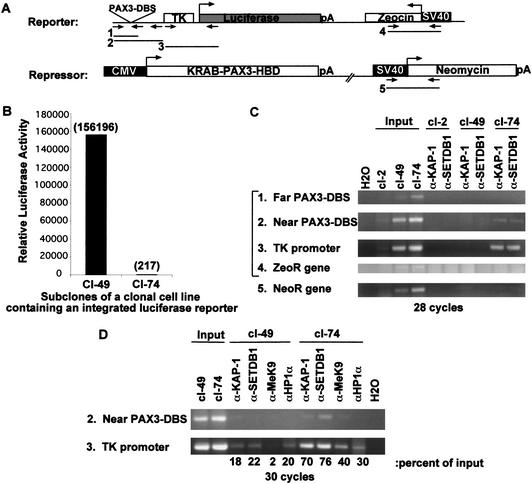Figure 7.
The KRAB–KAP-1 repression system targets SETDB1 and enhances H3-K9 methylation and HP1 recruitment to promoters of transcriptionally silenced genes. (A) Schematic representation of a two-plasmid system used to create a stably integrated luciferase transgene in NIH/3T3 cells that is regulated by a heterologous KRAB repressor protein. Numbered arrow sets represent the relative position of PCR primers used for PCR amplification of DNA retained by ChIP. (B) Two single-cell subclones containing the heterologous KRAB–PAX3–HBD transcriptional repressor and the integrated luciferase transgene, which is either expressed (cl-49) or stably silenced (cl-74) following hormone treatment. Luciferase activities were measured in subconfluent populations of cells and reported as relative light units per milligram of protein. (C) ChIP experiments showing the colocalization of KAP-1 and SETDB1 at the TK promoter region of the luciferase transgene in the cells where transcription of the luciferase gene has been stably silenced (cl-74). Formaldehyde cross-linked chromatin from cl-49 and cl-74 cells was immunoprecipitated with either affinity-purified KAP-1 or SETDB1 IgG. An equal amount of promoter sequence in cl-49 and cl-74 nucleosomal preparations was determined by PCR from 1% of the input chromatin. PCR-amplified DNA fragments are illustrated in A. cl-2 represents a negative control cell line. (D) ChIPs of cross-linked chromatin with KAP-1, SETDB1, HP1α, and MeK9 antiserum as in C. Bold numbers below each lane represent quantitation of amplified DNA, expressed as percentage of signal intensity for the amplified input DNA.

